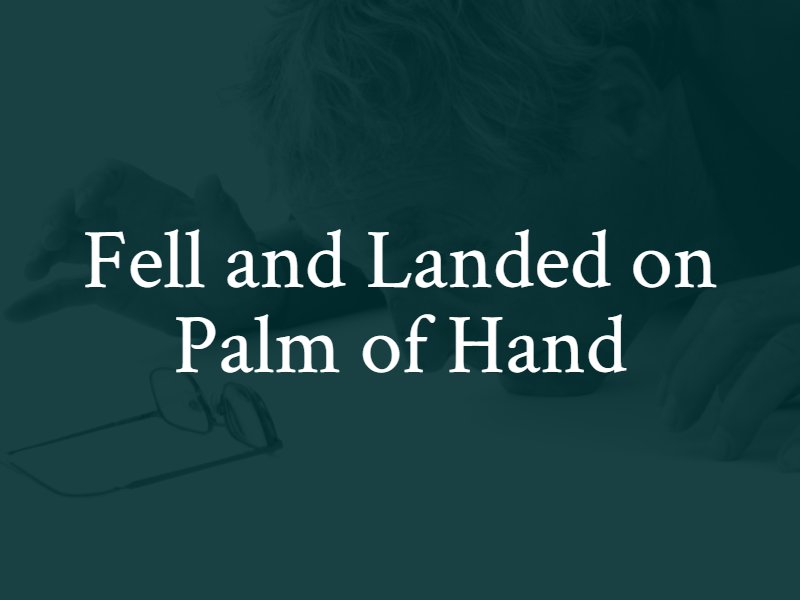Injuries From Falling and Landing on Your Hands
Injuries From Falling and Landing on Your Hands
Falls and the injuries they cause are a pervasive threat across the United States. Though most slip-and-fall research focuses on the elderly population, over 800,000 people visit the emergency room annually for fall-related injuries.
One common outcome of such falls is injuries from falling and landing on your hands, including wrist injuries, hand fractures, and broken fingers. These injuries often occur when individuals instinctively extend an outstretched hand to break a fall. Factors like osteoporosis and poor physical health can increase the risk of broken bones, but anyone can experience these injuries regardless of age.
If someone else’s negligence caused you to suffer such an injury, contact a Riverside personal injury lawyer today to explore your rights and see if you are eligible for compensation.

Dangerous Conditions Leading to Fall Injuries
Falls frequently happen under specific conditions. Inclement weather, such as ice or rain, can make surfaces dangerously slippery. Many of these accidents occur when property owners fail to remove snow or ice accumulations on stairs and walkways within a reasonable amount of time, causing visitors to stores, restaurants, apartments, or other premises to slip and fall.
Uncleaned spills, obstacles, and properties in disrepair can also cause visitors to slip and land on their hands, causing sprains, fractures, and other injuries.
Similarly, labor-intensive workplaces, including warehouses and construction sites, pose significant risks. According to the U.S. Centers for Disease Control and Prevention (CDC), one out of every five falls results in serious injury, including common wrist injuries like fractures and dislocations.
Hand and Wrist Fractures From Falling
While injuries to the hand or wrist may seem less severe than fractures of larger bones, their impact can be severe. The small bones in the hand and wrist are particularly vulnerable. When these bones break, they can lead to complications during the healing process and significant disruptions to daily life, even leading to arthritis as the years pass.
Common FOOSH Injuries
A fall on an outstretched hand (“FOOSH”) can result in several types of fractures. FOOSH injuries vary in severity and can involve the wrist, forearm, or even the proximal humerus, the upper part of the arm bone located just below the shoulder joint. The specific damage depends on factors like the force of impact and the angle at which the hand absorbs the fall.
These include:
- Scaphoid fractures: A fracture in the scaphoid bone—one of the small bones at the base of the wrist, can be extremely painful and greatly limit the use of the injured hand. These injuries often happen in a slip and fall accident or while playing sports. Unlike other fractures, a scaphoid fracture may not always show visible deformity, though you may experience pain and difficulty moving your thumb or wrist. Diagnosing a scaphoid fracture often requires an imaging test, such as an X-ray.
- Colles’ fractures: The distal radius, one of the two forearm bones, is commonly broken during falls. Known as a “broken wrist,” a Colles’ fracture accounts for approximately 10% of all annual fractures. Severe cases may involve multiple fractures or bones protruding through the skin.
- Boxer’s fractures: These fractures occur when the small bones of the hand break, typically during high-impact activities or a fall. Despite their name, they are not exclusive to boxers.
- Radial head fractures: A fracture near the elbow involving the radial head can occur if a fall impacts the arm’s alignment. This type of injury often restricts the range of motion and may require medical attention to restore proper function.
Symptoms of FOOSH injuries often include swelling, trouble moving the affected area, and intense pain. Seek medical attention promptly if you suspect a fracture.
The Impact of Wrist and Hand Injuries
Even minor injuries, such as fractures to the lunate bones or the scapholunate ligament, can disrupt everyday activities.
The lunate bones are crescent-shaped bones located in the center of the wrist, forming part of the carpal bones that connect the forearm to the hand.
The scapholunate ligament is a key soft tissue structure that stabilizes the scaphoid and lunate bones, allowing smooth wrist movements.
Tasks like writing, typing, and even cooking become challenging when these areas are injured. Without proper care, complications can arise, including poor circulation, limited mobility, or even bacterial infection in cases of open fractures.
Prolonged Healing Process
Recovery from hand and wrist injuries often requires a few weeks to several months, depending on severity. For example:
- A distal radius fracture may require immobilization for extended periods.
- Injuries involving the ulnar nerve can lead to ongoing pain and reduced function.
During recovery, it’s critical to avoid placing too much stress on the injured area, as this could prolong the healing process or require additional surgical treatment.
The Role of Small Bones in Recovery
The hand and wrist contain intricate networks of small bones, including the scaphoid and lunate bones, which are vital for mobility. When these bones are injured, it affects not only the hand but also the arm’s overall functionality.
- Soft tissue injuries, like ligament tears, often accompany fractures.
- Misaligned healing can result in permanent deformities requiring further treatment or even corrective surgery.
Life After a Hand or Wrist Injury
Recovering from a serious hand, wrist, or finger injury involves more than just physical healing. The psychological and financial impact can be significant. Loss of income during recovery, coupled with medical expenses, often places undue stress on individuals and families.
- Physical therapy can aid in restoring the hand’s range of motion and strength.
- Using an ice pack and anti-inflammatory medication can help reduce swelling during the early stages of recovery.
Complications and Compensation for Falling on Hands
Injuries to the hands, wrists or fingers often require months of rest and recovery. Depending on the injured party’s circumstances, this may mean a short-term loss of wages and income. If the injury occurred in the workplace, it may be possible to receive workers’ compensation for the fracture, depending on the circumstances that led to the fall.
Regardless of the situation, a hand injury – though small in size – often has huge implications. Complications from injuries to small bones often occur during the healing process. Small bones do not heal as easily as larger ones, and they can require longer recovery time or surgery.
If your fall occurred because of someone else’s negligence, contact a Riverside accident lawyer to see how they can help you get compensation for your hand or wrist injury.


